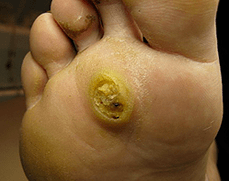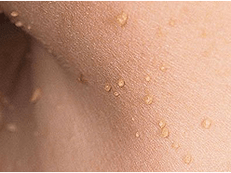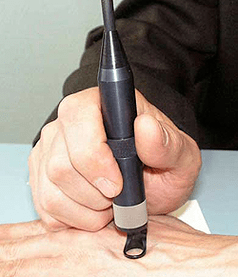Papilloma - The formation of benign tumors and mucous membranes of the etiology of the virus.It has a papilla appearance on a narrow base (feet), soft or dense consistency, from light to dark brown.The localization of papilloma on the skin leads to the formation of cosmetic defects, in the respiratory tract, voice, on the mucous membranes of the internal organs - ulceration and bleeding.Delivery of disease is possible, the greatest complication is malignant degeneration.Papill removal can be carried out by electrocoagulation, cryodestruction, surgical isolation, radio wave method or laser exposure.
General information
Papillomas - This is a disease that affects epithelial and skin cells.The cause of papillomas is a human papillomavirus, owned by the Papoviridae family, a papillomavirus group.Between HPV, viruses with high and low oncogenic risks are distinguished.Onkogenic papillomas are explained by the ability of the virus to integrate the DNA into the human cell genome.
The mechanism of infection with human papilloma virus
Once in the human body, in the early stages, HPV affects the basal cells of the epithelium.Microtrauma, scuffs, cracks and other skin damage contribute to the penetration of the papilloma virus into the body.For a long time, the virus can be multiplied, not clinically (chronic cars).If the virus is transmitted to the skin surface, then over time, even with the chronic transport of papilloma virus, cell hyperplasia is observed.
Because the human papilloma virus is nesting in the external environment, the infection occurs with direct contacts.Sexual relations enforced lead to infection;Smoking, pregnancy, endometriosis, vitamin deficiency, immunodeficiency is a predisposing factor so that infection occurs when interacting with the virus.The risk of infection increases with frequent contact with naked human skin, for example, with massage.
Clinical manifestations of papilloma
Papilloma is a skin neoplasm or mucous membrane and looks like a prominent papillary growth on the surrounding tissue.Papillomas are located on the skin, mucous membranes, in the inguinal region and in the genitals, in some cases, papilloma is found in the kidney pelvis and mucous membranes of the ureters.
Because papilloma is made up of connective tissue covered with skin and contains blood vessels, bleeding may occur during trauma.Neoplasms grow upward in the form of papillae scattered in a variety of directions and look like cauliflower.
Skin skin may not change, but in most cases papilloma has color from white to dirty brown.Favorite localization - brush skin and hands.In patients with immunodeficiency, widespread papillomatosis.The main changes in the skin begin to appear 1-6 months after the infection.The concentration of the virus in the affected area reaches a maximum of the 6th month of the time of the infection, this is the most contagious period.
Depending on the type of virus, the clinical manifestation of papilloma is changing.Therefore, coarse papillomas look in the form of a solid lump with a diameter of 1 mm with a rough keratinizing surface.Papilloma vulgar is exposed to mergers, and therefore often affects significant skin areas.Simple (rough) papillomas are located anywhere, but more often they are affected by the skin and back of the palm.In children, especially young people are influenced by papillomas, this is due to physiological features, because children crawl without clothing.Usually, coarse papillomas are located in groups, but the existence of prolonged single elements may have been possible for several years.The condition of immunodeficiency and general disease contributes to the spread of the process, in the case of isolated, coarse papilloma is malignant.

The papilloma -causing agent is PAPC 1.2.4.A few months after a single skin infection, a small excellent bump appears, which has all the ordinary signs of papilloma and surrounded by prominent rims.In some cases, small -sized subsidiaries appear around one papilloma, which resembles a bubble.Then mosaic papillomatosis is diagnosed.
Papillomas on the feet often hurt, especially when walking.In about 30% of cases, they themselves, more often in children.They are often confused by corn that appear between the fingers -prolonged compression.However, corn, unlike papilloma, has a smooth surface and maintains a skin pattern.
The agent of the flat papilloma is HPV 3.10.Papillomas are the color of the skin that is unchanged and looks in the form of a smooth flat cone, sometimes there is a yellowish shade or a little more rounded pink.Multiple papillomas are also found.Neoplasms cause pain, itching, the affected area is hyperemic.

Film papillomas are diagnosed in half of those who have turned older than 50 about neoplasms on the skin, they are also called acrochords.They are located on the skin around the eyes, on the thighs, in the axillary cavity and the neck.First, a small yellow shade appears, which continues to rise and gradually transforms into a dense elastic formation of up to 5-6mm.If the acrochords are located in places where trauma is possible, then they become inflamed and hurt.Film papillomas are not exposed to spontaneous loss.In patients with diagnosed papillomas, rectal polyps are often observed.
HPV 13, 32 causes local epithelial hyperplasia, characterized by appearance on the mucous membranes of the mouth and on the red border of the small papillary neoplasm, which slightly rises on the skin and is exposed to the combination.
One of the rare papillomas is Papillomas Lewandovsky-Lutz (Warty Epidermodisphelia).Most children and teens are sick.Sometimes Warty's epidermodisplasia is a family character.It looks like a clinical like multiple brown papillomas in your hands and feet.If the papilloma is located in the skin area, which is most vulnerable to ultraviolet radiation, then in 30% of their malignant cases and re -born into malignant tumors with proliferation into neighboring tissues.
HPV, which is a sharp pathogen of condils, can be at the risk of low, medium and high oncological degeneration, so when diagnosing sharp confectionils, PCR exams are always required.The incubation period is from several weeks to several months.Because in some cases, the change is minimal, the papilloma remains unknown.The main delivery path is sexual.Risk groups include people with immunodeficiency and often change sexual partners.Outside, they look like pink or pale gray growth that points to the feet.
In most cases, pain, burning, itching, irritation when touching and friction with underwear, often injured and bleeding.They are localized on the vagina night, on small labia, less frequent, spicy condylomas are found in the vagina and on the cervix.In men, the urethra holes are affected.The damage zone depends on sexual behavior in this way, in people who practice anal contacts, condiloma found in the perineum and in the perianal zone.In some cases, the indicated condiloma is diagnosed on the oral mucosa and on the red border of the lips, which is again associated with the features of sexual activity.
Papillomas juvenile laryngeal is rarely recorded, they are caused by HPV 6.11;For the most part, children under five are sick.Infections occur during childbirth, when women working on labor have papilloma in the vagina and children as they pass through the birth canal, take a premature breath.The disease is characterized by papillary growth in the vocal bundles, leading to difficulty of air circulation and speech disorders.
Diagnosis of papillomas
Diagnosis of papillomas is made by a dermatologist or venereologist.Due to a large number of viruses, it has its own features.It is possible to make an accurate diagnosis based on visual examination only in the classic case of sharp warts, but this does not provide accurate information on the type of virus and oncogenic.Therefore, if suspected papillomatous neoplasmic properties, they use diagnostic PCR DNA virus.
PCR diagnostics not only confirm the presence of human papillomavirus in the body and determine its type, but also to diagnose how many viruses in the body are at the time of analysis.This has a diagnostic value, as it knows the percentage of virus content and its type, you can determine the duration of the estimated infection and identify the contact person to examine and prescribe preventive therapy.PCR diagnostics also provide information on whether papilloma has a chronic course or they are the result of simultaneous decline in immunity.Thanks to such data, adequate therapy can be prescribed.
If one of the treatment methods is the removal of papillomas, then in line with surgery, biopsy is conducted for cytological research.Histological examination of papillomas tissue provides more accurate results, as the examination is subject to cells, so the correct location of their layer and the features of the tissue structure.This produces reliable results on the level of change in the body and about the probability of violence, as long and non -papillomas are more often leading to cancers than HPV detected with high levels of oncoris.
As a rule, PCR's diagnostics are natural examination and, if the analysis confirms the presence of the virus, then additional studies are conducted.
Papilloma treatment

The papilloma treatment regimen in each case is individually selected.If HPV is detected during diagnosis, but there is no clinical manifestation, then preventative therapy is prescribed by cytostatic.It is quite effective and allows you to "draw" the virus for several years.Patients with HPV carriers are recommended to conduct regular PCR examinations and use contraceptive barriers, so as not to endanger human papillomavis infections with their partner.
Inozin Pranobex is a remedy for the treatment of papilloma from a group of antiviral agents, which suppresses virus reproduction.It is one of the most liked, as it has immunomodulation.Indications for use are diagnosed with papilloma with a combination of other viral infections, such as cytomegalovirus infections, measles and gondok.The presence of herpes virus, chronic viral hepatitis and immunodeficiency also require the inclusion of isoprinosine in the treatment regimen.Due to long papilloma therapy, Papillo Pranobex should only be taken under the supervision of a doctor, as it is necessary to control laboratory guidance.The use of immunomodulators and vitamins is shown to all patients with HPV.
If there is a manifestation of HPV on the skin and mucous membranes, then, depending on localization and symptoms, using cryodestruction papillomas, electrokoagulation or removal of papill laser.It is possible to use the modern method of surgical treatment -Removal papillomas with radio waves.If the papilloma has signs of violence, then isolation is done with a knife in the affected area with healthy tissue capture.
Keep in mind that the removal of papillomas does not lead to complete recovery, as today there are no detailed drugs on HPV.Therefore, patients with previously diagnosed papilloma need to have regular examinations and conduct an antiviral therapy course.
Because HPV is especially sexually transmitted, one of the prevention of papillomas is a contraceptive barrier method.When planning a pregnancy, it is necessary to diagnose and, if needed, then the virus treatment to reduce the possibility of childhood infection during childbirth and in the first years of life.


















